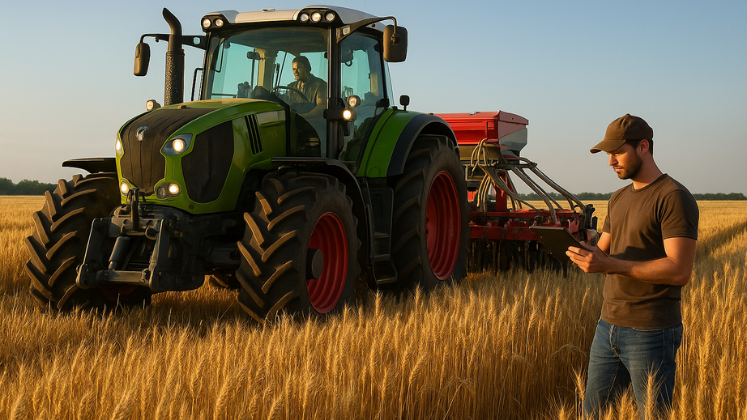Agriculture has always been the backbone of many economies, but with the changing climate and growing demand for food, it has become more crucial to adopt innovative farming methods. Among these innovations, mechanized farming stands out as a key factor in increasing yields, improving efficiency, and reducing operational costs.
By utilizing modern machinery and technology, farmers can achieve more with less, which ultimately leads to sustainable agricultural practices.
The efforts to revolutionize Pakistan’s agricultural landscape with Mechanized Agricultural Operations (MAO) are driving significant progress in the industry.
What is Agricultural Mechanization?
This term refers to the integration of advanced machines and technology to perform essential farming tasks such as planting, irrigation, harvesting, and crop maintenance. This shift from traditional manual methods to mechanized farming results in enhanced efficiency and reduced labor costs.
Key Benefits of Mechanized Farming
1. Increased Productivity and Efficiency
One of the most significant advantages of mechanized farming is the substantial increase in productivity. With mechanized tools, tasks like plowing, planting, and harvesting can now be completed in a fraction of the time. As a result, more crops can be grown, maintained, and harvested, leading to increased output from the same amount of land.
2. Reduction in Labor Costs
Mechanization reduces the need for large amounts of manual labor, which is particularly beneficial in regions facing labor shortages. By utilizing advanced machinery, farms can operate with fewer workers, saving on wages and reducing dependence on seasonal labor.
3. Improved Crop Quality
Modern machinery ensures that tasks such as planting, irrigation, and harvesting are carried out optimally, leading to better crop health and higher yields. For example, precision planting and seeding machines allow farmers to place seeds exactly where they are needed, reducing waste and increasing germination rates.
4. Enhanced Sustainability
Mechanized farming helps improve sustainability by using resources more efficiently. Precision irrigation systems, for instance, ensure that water is delivered directly to the plant’s roots, reducing water waste. Additionally, mechanized systems can operate on a larger scale, enabling farmers to implement more sustainable farming practices.
5. Cost Savings Over Time
Although the initial investment in machinery can be significant, mechanization pays off in the long run. Over time, machines reduce the costs associated with labor, fuel, and other inputs. Additionally, the increased efficiency and yield mean that farmers can scale their operations without sacrificing quality, further enhancing profitability.
Types of Agricultural Mechanization
Mechanization can be categorized into various types depending on the task:
- Primary Mechanization: Involves basic machinery like tractors and plows used for land preparation and crop planting.
- Secondary Mechanization: Includes equipment like seeders, transplanters, harvesters, irrigation systems, and crop monitoring technologies that enhance farm operations after the initial planting phase.
- Automation and Robotics: The future of agriculture lies in autonomous systems such as robotic transplanters and harvesters, drones for crop monitoring, and AI-powered equipment that can operate without human intervention.
Challenges and Considerations
While mechanization offers numerous benefits, there are some challenges to consider:
- High Initial Costs: The purchase and maintenance of machinery can be a significant barrier, especially for smaller farms. Leading companies should understand this challenge and work closely with farmers to provide financial solutions that make mechanization accessible.
- Technology Accessibility: In many rural areas, farmers may not have easy access to the latest machinery or the technical knowledge required to operate it. At government level, farmers should be offered the formal education , machinery, and training they need to succeed.
The Future of Mechanized Farming
Looking ahead, precision agriculture is set to take mechanized farming to the next level. With the integration of data analytics and artificial intelligence, future farming systems will be more intelligent, more precise, and more efficient.
At Meskay & Femtee, we’re already exploring these innovations to improve the farming experience further. Through the use of cutting-edge Kubota agricultural machinery, our Agri Division is committed to delivering high-quality, cost-effective solutions to farmers, empowering them to maximize their productivity and profitability.
FAQs
1. What is the role of mechanized farming in increasing agricultural productivity?
Mechanized farming increases efficiency by performing tasks faster and with greater precision, leading to higher yields from the same amount of land.
2. How does mechanization reduce farming costs?
It reduces labor costs, minimizes resource waste, and increases the overall productivity of farms, which leads to long-term savings.
3. Can small farms afford mechanized farming?
Though the initial cost is high, financial support, loans, and training programs can help make mechanization accessible to smaller farms.
4. How does mechanization improve crop quality?
Machines ensure precise planting, irrigation, and harvesting, which minimizes crop damage and ensures better yield quality.


Leave a Reply